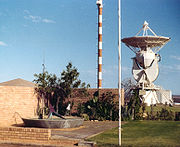
Carnarvon Tracking Station
Encyclopedia

Western Australia
Western Australia is a state of Australia, occupying the entire western third of the Australian continent. It is bounded by the Indian Ocean to the north and west, the Great Australian Bight and Indian Ocean to the south, the Northern Territory to the north-east and South Australia to the south-east...
was a tracking station built in 1963 for use by NASA
NASA
The National Aeronautics and Space Administration is the agency of the United States government that is responsible for the nation's civilian space program and for aeronautics and aerospace research...
for the Gemini program, the second step for NASA's
NASA
The National Aeronautics and Space Administration is the agency of the United States government that is responsible for the nation's civilian space program and for aeronautics and aerospace research...
plan to put a human on the Moon. It replaced the Muchea Tracking Station
Muchea Tracking Station
Established in 1960, Muchea Tracking Station was built specifically for NASA's Project Mercury. It was Station No. 8 of 14 sites around the world used throughout the project. The only other Australian site was No...
and used some of the equipment from Project Mercury
Project Mercury
In January 1960 NASA awarded Western Electric Company a contract for the Mercury tracking network. The value of the contract was over $33 million. Also in January, McDonnell delivered the first production-type Mercury spacecraft, less than a year after award of the formal contract. On February 12,...
.
The Station also included an FPQ-6
AN/FPQ-6
The AN/FPQ-6 is a fixed, land-based C-band radar system used for long-range, small-target tracking. The AN/FPQ-6 Instrumentation Radar located at the NASA Kennedy Space Center was the principal C-Band tracking radar system for Apollo program....
precision tracking radar, a STADAN
Spacecraft Tracking and Data Acquisition Network
The Spacecraft Tracking and Data Network was established by NASA to satisfy the requirement for long-duration, highly-available space-to-ground communications...
scientific satellite tracking facility, a planet Jupiter
Jupiter
Jupiter is the fifth planet from the Sun and the largest planet within the Solar System. It is a gas giant with mass one-thousandth that of the Sun but is two and a half times the mass of all the other planets in our Solar System combined. Jupiter is classified as a gas giant along with Saturn,...
monitoring system, and a Solar Particle Alert Network (SPAN) facility. Together these facilities formed the largest station in the NASA network outside mainland USA.
After the conclusion of the Gemini program, Carnarvon Tracking Station provided extensive support for the Project Apollo
Project Apollo
The Apollo program was the spaceflight effort carried out by the United States' National Aeronautics and Space Administration , that landed the first humans on Earth's Moon. Conceived during the Presidency of Dwight D. Eisenhower, Apollo began in earnest after President John F...
missions to the Moon. By reason of Carnarvon's unique geographical position it was used to uplink the Trans Lunar Injection (TLI) command to the Apollo spacecraft and was prime for the last hours of re-entry to Earth.
To enhance critical communications between the station and the Houston Control Centre, NASA funded the near-by OTC Satellite Earth Station Carnarvon
OTC Satellite Earth Station Carnarvon
The OTC Satellite Earth Station Carnarvon was established to meet the need for more reliable and higher quality communications for NASA's Apollo Moon project...
in 1966.
After Project Apollo finished, the Carnarvon Tracking Station continued with the Skylab
Skylab
Skylab was a space station launched and operated by NASA, the space agency of the United States. Skylab orbited the Earth from 1973 to 1979, and included a workshop, a solar observatory, and other systems. It was launched unmanned by a modified Saturn V rocket, with a mass of...
project. When Skylab finished the station ceased routine operations immediately after an AE-C pass on Friday, 4 October 1974 but retained sufficient capability for one final mission - the trans-solar insertion of Helios-A on 10 December 1974. The final closure of the gates and exodus of the last five staff members took place on 18 April 1975.
The main building was then used by Radio Australia who were looking for a home after Cyclone Tracy
Cyclone Tracy
Cyclone Tracy was a tropical cyclone that devastated the city of Darwin, Northern Territory, Australia, from Christmas Eve to Christmas Day, 1974...
put their Darwin installation out of commission. They closed this facility in June 1996. All Tracking Station equipment was removed and/or buried and all buildings, with the exception of one small one now used by Telstra, were razed. Only the foundations of what is an historical site remain.
Solar scientific research, originally carried out at the Carnarvon Tracking Station, is now carried out on the adjacent OTC Satellite Earth Station Carnarvon
OTC Satellite Earth Station Carnarvon
The OTC Satellite Earth Station Carnarvon was established to meet the need for more reliable and higher quality communications for NASA's Apollo Moon project...
site, which hosts a node of the Birmingham Solar Oscillations Network
Birmingham Solar Oscillations Network
The Birmingham Solar Oscillations Network consists of a network of six remote solar observatories monitoring low-degree solar oscillation modes. It is operated by the High Resolution Optical Spectroscopy group of the School of Physics and Astronomy at the University of Birmingham, UK, in...
.
See also
- Carnarvon and Apollo: one giant leap for a small Australian town" by Paul Dench & Alison Gregg; Rosenberg, May 2010
- Honeysuckle Creek Tracking StationHoneysuckle Creek Tracking StationHoneysuckle Creek was a NASA tracking station near Canberra, Australia, which played an important role in supporting Project Apollo. The station was opened in 1967 and closed in 1981....
External links
- CarnarvonSpace.com Book and website
- Crotrak.com Website

